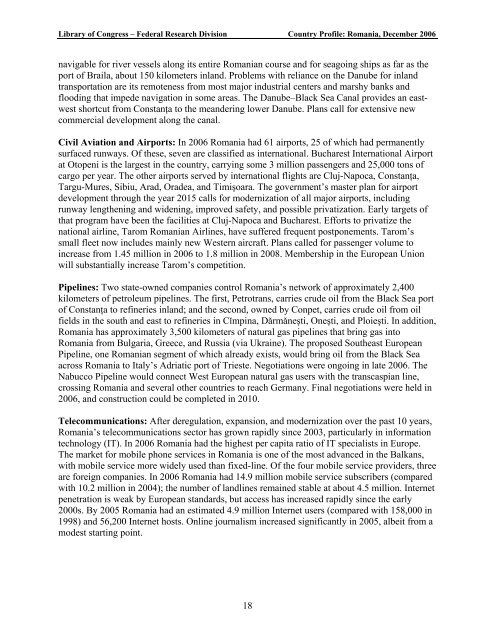Country Profile: Romania - Library of Congress
Country Profile: Romania - Library of Congress
Country Profile: Romania - Library of Congress
You also want an ePaper? Increase the reach of your titles
YUMPU automatically turns print PDFs into web optimized ePapers that Google loves.
<strong>Library</strong> <strong>of</strong> <strong>Congress</strong> – Federal Research Division <strong>Country</strong> <strong>Pr<strong>of</strong>ile</strong>: <strong>Romania</strong>, December 2006<br />
navigable for river vessels along its entire <strong>Romania</strong>n course and for seagoing ships as far as the<br />
port <strong>of</strong> Braila, about 150 kilometers inland. Problems with reliance on the Danube for inland<br />
transportation are its remoteness from most major industrial centers and marshy banks and<br />
flooding that impede navigation in some areas. The Danube–Black Sea Canal provides an eastwest<br />
shortcut from Constanţa to the meandering lower Danube. Plans call for extensive new<br />
commercial development along the canal.<br />
Civil Aviation and Airports: In 2006 <strong>Romania</strong> had 61 airports, 25 <strong>of</strong> which had permanently<br />
surfaced runways. Of these, seven are classified as international. Bucharest International Airport<br />
at Otopeni is the largest in the country, carrying some 3 million passengers and 25,000 tons <strong>of</strong><br />
cargo per year. The other airports served by international flights are Cluj-Napoca, Constanţa,<br />
Targu-Mures, Sibiu, Arad, Oradea, and Timişoara. The government’s master plan for airport<br />
development through the year 2015 calls for modernization <strong>of</strong> all major airports, including<br />
runway lengthening and widening, improved safety, and possible privatization. Early targets <strong>of</strong><br />
that program have been the facilities at Cluj-Napoca and Bucharest. Efforts to privatize the<br />
national airline, Tarom <strong>Romania</strong>n Airlines, have suffered frequent postponements. Tarom’s<br />
small fleet now includes mainly new Western aircraft. Plans called for passenger volume to<br />
increase from 1.45 million in 2006 to 1.8 million in 2008. Membership in the European Union<br />
will substantially increase Tarom’s competition.<br />
Pipelines: Two state-owned companies control <strong>Romania</strong>’s network <strong>of</strong> approximately 2,400<br />
kilometers <strong>of</strong> petroleum pipelines. The first, Petrotrans, carries crude oil from the Black Sea port<br />
<strong>of</strong> Constanţa to refineries inland; and the second, owned by Conpet, carries crude oil from oil<br />
fields in the south and east to refineries in Cǐmpina, Dǎrmǎneşti, Oneşti, and Ploieşti. In addition,<br />
<strong>Romania</strong> has approximately 3,500 kilometers <strong>of</strong> natural gas pipelines that bring gas into<br />
<strong>Romania</strong> from Bulgaria, Greece, and Russia (via Ukraine). The proposed Southeast European<br />
Pipeline, one <strong>Romania</strong>n segment <strong>of</strong> which already exists, would bring oil from the Black Sea<br />
across <strong>Romania</strong> to Italy’s Adriatic port <strong>of</strong> Trieste. Negotiations were ongoing in late 2006. The<br />
Nabucco Pipeline would connect West European natural gas users with the transcaspian line,<br />
crossing <strong>Romania</strong> and several other countries to reach Germany. Final negotiations were held in<br />
2006, and construction could be completed in 2010.<br />
Telecommunications: After deregulation, expansion, and modernization over the past 10 years,<br />
<strong>Romania</strong>’s telecommunications sector has grown rapidly since 2003, particularly in information<br />
technology (IT). In 2006 <strong>Romania</strong> had the highest per capita ratio <strong>of</strong> IT specialists in Europe.<br />
The market for mobile phone services in <strong>Romania</strong> is one <strong>of</strong> the most advanced in the Balkans,<br />
with mobile service more widely used than fixed-line. Of the four mobile service providers, three<br />
are foreign companies. In 2006 <strong>Romania</strong> had 14.9 million mobile service subscribers (compared<br />
with 10.2 million in 2004); the number <strong>of</strong> landlines remained stable at about 4.5 million. Internet<br />
penetration is weak by European standards, but access has increased rapidly since the early<br />
2000s. By 2005 <strong>Romania</strong> had an estimated 4.9 million Internet users (compared with 158,000 in<br />
1998) and 56,200 Internet hosts. Online journalism increased significantly in 2005, albeit from a<br />
modest starting point.<br />
18

















